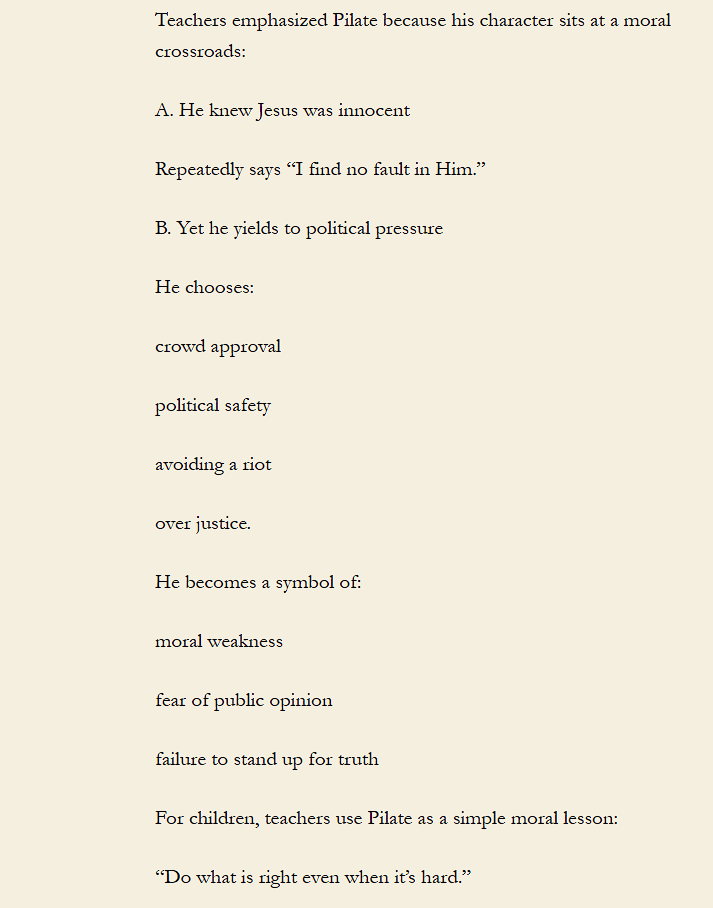stock here. One of the things I remember deeply from from early life is the name of Pontius Pilate. Even now I think of Unconscious Pilot, but the irony only starts there……A-Eye of course, but useful. Especially if you push back on the first responses most likely to be 100% mainstream.
Let me summarize, this Epic Jerk, did authorize the execution of Jesus, even though he find no fault, but if he could avoid a riot (paid most likely just like today’s protests)
———————–

Pontius Pilate shows up in childhood teaching for one reason above all others:
⭐ He is the most historically documented Roman official directly connected to the life and execution of Jesus.
But the fuller reason is deeper — and more interesting. Here’s the expanded explanation in a clean, structured way.
✅ 1. Why Pilate was so central in childhood Christian teaching
A. He is the Roman authority who condemned Jesus to crucifixion.
Every Gospel mentions him prominently.
He is the political bridge between:
the Roman Empire
the Jewish leadership
the execution of Jesus
Because the Crucifixion is the central event of Christianity, Pilate becomes an unavoidable character in the story.
B. He speaks directly to Jesus in the Gospels.
His conversations with Jesus are famous:
“What is truth?”
“I find no fault in this man.”
These dialogues stuck in children’s lessons because they’re dramatic and morally charged.
C. His name appears in the Apostles’ Creed
Many Christian kids memorized:
“Born of the Virgin Mary, suffered under Pontius Pilate, was crucified, died, and was buried.”
This single line ensured his name was repeated generation after generation.
The creed intentionally includes Pilate to root the story of Jesus in real history, not myth.
✅ 2. Why historians care about Pilate
Before 1961, critics claimed Jesus’s trial and Pilate’s role were inventions or exaggerations.
That ended with one discovery:
🎯 The Pilate Stone (1961)
Found at the Roman theater in Caesarea Maritima.
The inscription literally reads:
“Pontius Pilatus, Prefect of Judea…”
plus a dedication to Emperor Tiberius.
That’s rock-solid archaeological evidence.
Combined with:
Josephus
Tacitus
Philo of Alexandria
Gospel accounts
→ Pilate is one of the best-attested Roman prefects of the 1st century.
✅ 3. Why Pilate is morally memorable
Teachers emphasized Pilate because his character sits at a moral crossroads:
A. He knew Jesus was innocent
Repeatedly says “I find no fault in Him.”
B. Yet he yields to political pressure
He chooses:
crowd approval
political safety
avoiding a riot
over justice.
He becomes a symbol of:
moral weakness
fear of public opinion
failure to stand up for truth
For children, teachers use Pilate as a simple moral lesson:
“Do what is right even when it’s hard.”
✅ 4. Why Pilate’s story is repeated in Western culture
He appears in:
medieval passion plays
Renaissance art
modern films (Passion of the Christ, etc.)
the Nicene and Apostles’ Creeds
Easter liturgy
textbooks and historical references
His name is woven into the fabric of Western memory.
He is the only non-Jewish, non-Christian name that almost every child in the West learns.
⭐ 5. The unique position of Pilate in history
Pontius Pilate occupies a rare space:
A Roman governor
connected directly to Jesus
verified by archaeology
mentioned in multiple independent ancient sources
immortalized in creeds and liturgy
symbol of moral failure
politically charged figure in Judea
This combination is why his name never disappeared.
One reply on “Unconscious Pilot”
Just like we-all are experiencing:
Local “authorities” of the occupation forces will Lose their position if they cannot maintain order. How many of
us are carried away with the Crowd,
yelling for the hell of it: “Crucify Him!”
Here is your designated enemy, America! Show your loyalty by yelling
for the death penalty for the TV Patsy,
Manchurian Candidate brainwashed victim they shoved into the camera and
totally destroyed any fair trial for him.
Rome eventually, like 37 years later, came and destroyed Jerusalem, as the
zealot revolt, and Essene resistance was forced backed into Masada .
As we cruise into Merry Christmas time,
let’s remember that Herod, hearing of
the Messiah baby escaping from his
clutches, ordered the Slaughter of the
Innocents, about 3(?) years after the
Silent Night, Stille Nacht.
Behold the Star, choral tune by Dawson
puts me there on a clear night with the shepherds.